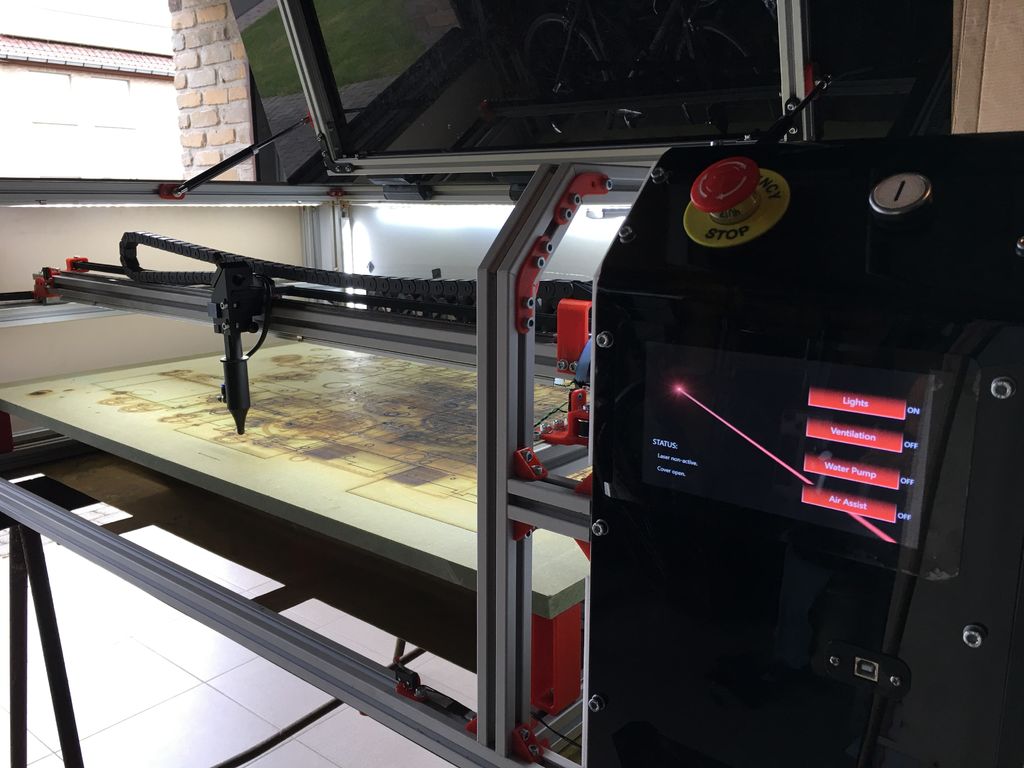Introduction
This first article will not be the most sensational because it will lay the foundations of the project: few images and many thoughts.
My workshop is in dire need of a laser cutting machine with a suitable working space (1000 * 500 mm minimum). Indeed, I can not comfortably progress in a project knowing that I will have to pay the high price for a prototype. Not only does it slow down ideas but it also increases the budget for future customers that I want to keep small and passionate. I have asked a quote for an Epilog (which I know well) and it gets immediately to more than 10k € … Ditto for equivalents on a wattage of 40 and a working space of this size.
The remaining options are cloned Chinese machines or kits to mount, for the modest sum of 5k € (approximately).
And then I remembered that I was an engineer so I started to consider the option of building it myself by combining the Internet experiences on the subject. And I wanted it to be an open-source project and well documented. For the pleasure of the eyes and for the readers who wish to follow my steps or to be inspired by them.
And everything begins behind an article, spreadsheets, videos, text files and wiki pages.
Inspiration
After a lot of research and comparisons, I decided to choose this Instructables. It has the great advantage of having been realised in a framed school setting with the aim of being able to be reproduced and with a real reflection. And even if it has some flaws, it is an excellent working base.
After reading the tutorial carefully, I read all comments in search of design problems. I also thought a lot myself about it since I had some mechatronics courses.
Here is what I learned from this work :
- The control of the laser tube must be calibrated by hand with an accurate measuring tool because the Chinese pilots are not precise. Do not just plug and trust the values (and burn the device)
- Do not connect the safety switch from the cover to the controller but directly to the power supply of the laser in a circuit breaker logic
- Do not connect the emergency stop button to the controller but directly to the main power supply
in a circuit breaker logic (the best way in my opinion would be to keep the power supply of the controller and that it detects the shutdown of ’emergency) - It would be interesting to add a gauge to adjust the focal length of the laser, a small piece that represents the focal length and which would be clipped on the element that creates the final beam to be able to make the adjustment with an immediate visual
- Add a place to put a spray of water in case of a small fire
- My plexiglass supplier does not give the smoke gray hue (which I find anyway too dark to follow the possible problems), it might be more interesting to put transparent Plexiglas for the cover with a CO2 laser protective film: point to work
- The machine control by Arduino / GRBL is not satisfactory
- A key switch is required between the power button and the power supply
- It would be nice to try to replace the MDF of support of pieces to be cut by a honeycomb (either new or recovery)
First step
Fablab
I can only advise you to register near your local Fablab to accompany you in this project. On the one hand because it’s totally in their philosophy and on the other one is because they know these machines and you will find a huge support.
So I enrolled at Plateform-C in Nantes to spend 4 hours a week (a little more if I count the time at home). There I was able to study the machines in place, chat with makers and technicians and then expand my possibilities of construction.
Planning
For me it is vital to cut the project in parts and to focus on each one (but keeping the overview in mind). A transverse task will be for me the discovery and tests of the motherboard, but I will come back to it later.
- Project study
- Making of the frame
- Assembly of the opto-mechanical parts
- Assembly of the panels
- Assembly of the electronics
- Programming
Shopping list
Then it is important to update the shopping list provided by the original article. Especially at the level of links that are not necessarily very clear and / or up to date. Here is the list of things that were difficult to find in France and / or to decipher:
- Aluminium profiles 30×30 B-Typ rainure 8
- Plexiglas
- Bolts and nuts
- Sliding T-nut hammer / 3030 / M3-30s
- T-nut hammer head / 3030 8mm / M5
- Key switch
- 12 fans
The list will be updated according to the progress of the project because I have not bought everything as I am currently focusing on stage 1 and 2.
Note on the control motherboard
The Fablab where I go has repaired several laser cutting and they know the makers of SmoothieBoard, so I contacted them directly to discuss this project and after another study I decided to replace the Arduino and motor drivers of the initial project by a SmoothieBoard 3XC. This increases the price a little, but it is possible to get rid of the RPI and the touch screen if you are on a budget.
The advantage of the SmoothieBoard is that I have RobotSeed support on the project and the community is active, the tutorials are very detailed and then the motherboard was developed only to do that and with a very correct processor.
Conclusion
So much for this first article. As long as the project is not finished, the articles of the series are evolutionary and they will take into account your remarks and suggestions if it lends itself to it. Of course, it would be a pleasure for me to read your feedback and comments. You can contact me here, by mail or by carrier pigeon.
Do not hesitate to tell me if you would like a similar machine, it is possible that I decide to help you to do it or to build one for you depending of how comfortable I am in this production.
All the articles regarding this series are here : DIY Lasercutter


Leave a Reply